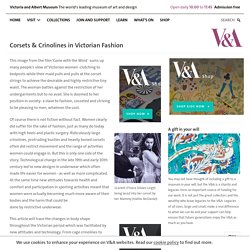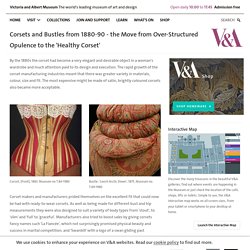

Corsets & crinolines in Victorian fashion. Scarlett O'Hara (Vivien Leigh) being laced into her corset by her Mammy (Hattie McDaniel) This image from the film 'Gone with the Wind` sums up many people's view of Victorian women -clutching to bedposts while their maid pulls and pulls at the corset strings to achieve the desirable and highly restrictive tiny waist.

The woman battles against the restriction of her undergarments but to no avail. She is doomed to her position in society: a slave to fashion, cosseted and striving to be pleasing to men, whatever the cost. Of course there is not fiction without fact. Women clearly did suffer for the sake of fashion, just as many do today with high heels and plastic surgery. Fashion plate, from the Petit Courier des Dames, February 1845 This article will trace the changes in body shape throughout the Victorian period which was facilitated by new attitudes and technology. In 1837 Victoria ascended to the throne. Unknown lady, daguerreotype, 1840s Crinoline cage, about 1860. Corsets and bustles from 1880-90 - the move from over structured opulance to the 'healthy corset' By the 1880s the corset had become a very elegant and desirable object in a woman's wardrobe and much attention paid to its design and execution.

The rapid growth of the corset manufacturing industries meant that there was greater variety in materials, colour, size and fit. The most expensive might be made of satin, brightly coloured corsets also became more acceptable. Corset, (front), 1883. Museum no T.84-1980 Bustle, 'Leech Arctic Down', 1875. Corset makers and manufacturers prided themselves on the excellent fit that could now be had with ready-to-wear corsets. Miss Leila Johnson, Photograph, 1885 In the mid 1880s, after a brief respite, bustles returned and in a more exaggerated form than before. Bustles came in all shapes and sizes. Guido Gonin, aquarelle, 1894 'The New Phantom' bustle, dating from about 1884, had a special feature. In the late 1880s, fashion moved on and the 'bustled' shape was no longer desirable. Without the bustle even stronger emphasis was placed on the waist. Glb8-57p166.jpeg 648×997 pixels. Glb8-57p165.jpeg 576×955 pixels. Crinolines, crinolettes, bustles and corsets from 1860-80.
From 1866 the crinoline craze began to subside.

In this year the magazine Le Follet announced: 'The size of the crinoline is very sensibly diminished, but it cannot be altogether dispensed with while the dresses are so very long'. This helps account for the small size of many crinolines in the Victoria and Albert Museum's collection, for example the red Thomson's crinoline of 1867. Punch, not to miss an opportunity for humour, anticipated a new use for discarded crinolines - as plant protectors during the winter!
They were fashionable between 1867 and the mid 1870s. They were often composed of half hoops with extra loops of steel at the top to give more support. Cage crinoline, manufactured by W S and E H Thomson, 1865-68. Crinolette, about 1870. Bustle, about 1875. During the 1870s the bustle became a separate undergarment in its own right. Punch, publication, 1874 Crinolettes and bustles were probably more restrictive than crinolines. 'The Wasp Waist', photograph, 1890s.
Victorian Corset - Historic Fashions.